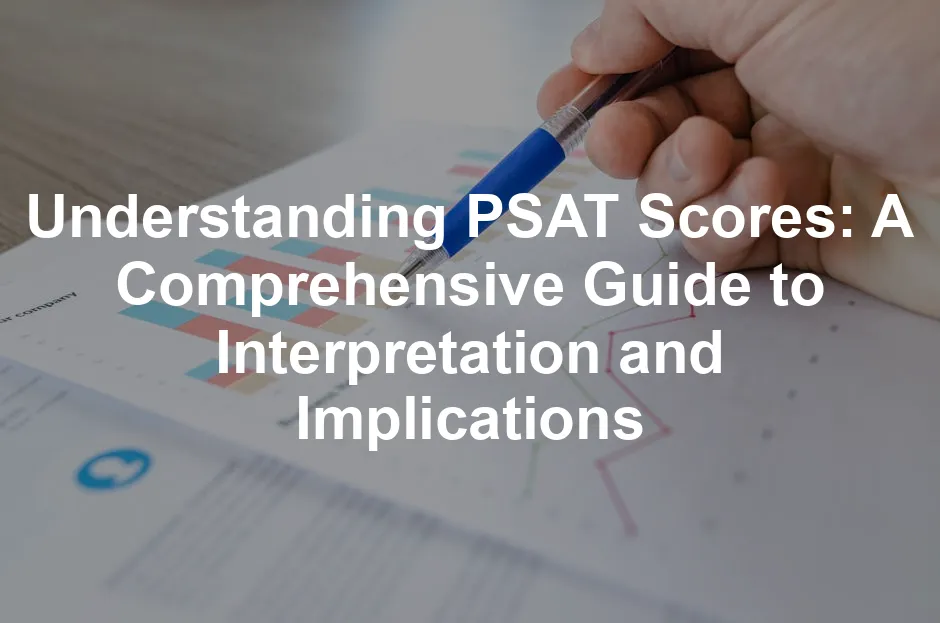
Section 5: Preparing for Future Tests
Using PSAT Scores to Guide SAT Preparation
Your PSAT scores are more than just numbers. They can significantly shape your SAT study plan. First, take a close look at your section scores. Identify areas where you excel and those that need work. For instance, if your Math score is high, focus on improving your reading and writing skills. Next, use your subscores to guide your study materials. Each subscore highlights specific skills. If your command of evidence is low, consider practice materials that target this area. Adapt your study resources based on your strengths and weaknesses. To keep track of your study schedule, an Academic Planner for Students is a must-have. This handy tool will help you stay organized and avoid last-minute cramming. No matter how you performed, keep preparing. A solid PSAT score doesn’t guarantee a similar SAT score. Continual practice ensures you stay sharp. Regularly revisit your study plan to accommodate any changes in your learning pace.Test-Taking Strategies
Test-taking strategies are crucial for success. Start by simulating the testing environment. Practice with timed sections to build your stamina. This helps you get used to the pressure of the actual test. Familiarize yourself with the SAT format. The PSAT gives you a taste of what to expect, but the SAT is more challenging. Understand the types of questions, especially in your weaker areas. Review common pitfalls that test-takers encounter. Additionally, develop a time management strategy. Allocate time for each question, and don’t dwell too long on any single item. If you get stuck, move on and come back later if time permits. This will help you maximize your score. Remember, the transition from PSAT to SAT can be daunting. However, with the right strategies, you can navigate this change successfully. Stay positive and confident in your preparation.
Conclusion
Understanding PSAT scores is essential for high school students and their families. These scores provide valuable insights for preparing for future standardized tests. They can enhance college applications and open doors to scholarships. A strong PSAT performance can lead to recognition, making it crucial to use these scores proactively. Take steps to improve your skills, and stay focused on your academic journey.Don’t forget to grab a pair of Noise-Canceling Headphones for Study. These bad boys will block out distractions and keep you focused on your studies.
Please let us know what you think about our content by leaving a comment down below!
Thank you for reading till here 🙂
All images from Pexels

Middle Scores (1100 to 1300)
A PSAT score between 1100 and 1300 reflects an average academic standing. It suggests that you are performing on par with many peers. This score can provide a solid foundation for future tests and college applications. However, there’s always room for improvement. Start by analyzing your section scores. Are you stronger in Math than in Evidence-Based Reading and Writing? Identifying these patterns helps target specific areas for growth. To fuel your study sessions, don’t forget to stock up on Study Snacks Variety Pack. Because who doesn’t need a little crunchy motivation while cramming?Low Scores (Below 1100)
If your PSAT score is below 1100, don’t be discouraged. This is an opportunity to grow and improve. Many students experience setbacks, and recognizing the need to enhance your study habits is the first step. Start by re-evaluating your approach to studying. Are you using effective techniques? Consider incorporating active learning strategies, like teaching concepts to someone else. This reinforces your understanding and highlights areas needing attention. Additionally, consider seeking help. A tutor can provide personalized strategies to overcome challenges. Practice with sample questions can also build confidence. Remember, improvement takes time, so be patient and persistent in your efforts.
Section 5: Preparing for Future Tests
Using PSAT Scores to Guide SAT Preparation
Your PSAT scores are more than just numbers. They can significantly shape your SAT study plan. First, take a close look at your section scores. Identify areas where you excel and those that need work. For instance, if your Math score is high, focus on improving your reading and writing skills. Next, use your subscores to guide your study materials. Each subscore highlights specific skills. If your command of evidence is low, consider practice materials that target this area. Adapt your study resources based on your strengths and weaknesses. To keep track of your study schedule, an Academic Planner for Students is a must-have. This handy tool will help you stay organized and avoid last-minute cramming. No matter how you performed, keep preparing. A solid PSAT score doesn’t guarantee a similar SAT score. Continual practice ensures you stay sharp. Regularly revisit your study plan to accommodate any changes in your learning pace.Test-Taking Strategies
Test-taking strategies are crucial for success. Start by simulating the testing environment. Practice with timed sections to build your stamina. This helps you get used to the pressure of the actual test. Familiarize yourself with the SAT format. The PSAT gives you a taste of what to expect, but the SAT is more challenging. Understand the types of questions, especially in your weaker areas. Review common pitfalls that test-takers encounter. Additionally, develop a time management strategy. Allocate time for each question, and don’t dwell too long on any single item. If you get stuck, move on and come back later if time permits. This will help you maximize your score. Remember, the transition from PSAT to SAT can be daunting. However, with the right strategies, you can navigate this change successfully. Stay positive and confident in your preparation.
Conclusion
Understanding PSAT scores is essential for high school students and their families. These scores provide valuable insights for preparing for future standardized tests. They can enhance college applications and open doors to scholarships. A strong PSAT performance can lead to recognition, making it crucial to use these scores proactively. Take steps to improve your skills, and stay focused on your academic journey.Don’t forget to grab a pair of Noise-Canceling Headphones for Study. These bad boys will block out distractions and keep you focused on your studies.
Please let us know what you think about our content by leaving a comment down below!
Thank you for reading till here 🙂
All images from Pexels

Understanding Percentiles
Percentiles are a way to understand how your score compares to other test-takers. If you’re in the 90th percentile, you scored better than 90% of students. Percentiles are calculated based on the overall performance of all test-takers. Knowing your percentile ranking is crucial. It indicates your readiness for college-level work. A higher percentile suggests you have a strong grasp of the material, which can be advantageous when applying to colleges. Understanding where you stand can help you target areas needing improvement.Section 2: Accessing Your PSAT Score Report
Components of the Score Report
Your PSAT score report provides a wealth of information. It includes several key sections that break down your performance. Let’s take a closer look at these components. Total Score: This is the overall score, ranging from 320 to 1520. It combines your scores from the two main sections: Evidence-Based Reading and Writing (EBRW) and Math. A higher total score indicates better performance. Section Scores: Each section receives a score between 160 and 760. The EBRW score reflects your abilities in reading and writing, while the Math score showcases your skills in mathematical reasoning. Subscores: These scores, ranging from 1 to 15, provide more granular insights. They assess specific skills within the main sections. For example, in EBRW, subscores evaluate command of evidence, words in context, and expression of ideas. This helps identify your strengths and areas for improvement. Cross-Test Scores: These scores range from 8 to 38 and assess your performance in analyzing information from history/social studies and science. This indicates how well you can apply your skills across different subjects. National Merit Scholarship Corporation Selection Index: This score is crucial for students aiming for the National Merit Scholarship. It’s calculated by summing your Math and EBRW scores and multiplying by two. A higher Selection Index score increases your chances of being recognized by the National Merit Program. Question-Level Feedback: This section breaks down your performance on individual questions. It shows which questions you missed and links them to the subscore categories. This feedback is invaluable for understanding where to focus your study efforts. Understanding these components is essential for interpreting your scores. Each part of the report offers insights that can guide your preparation for future tests and help you target areas needing improvement. By analyzing your score report, you can create a study plan tailored to your needs, setting you up for success on the SAT and beyond.
Middle Scores (1100 to 1300)
A PSAT score between 1100 and 1300 reflects an average academic standing. It suggests that you are performing on par with many peers. This score can provide a solid foundation for future tests and college applications. However, there’s always room for improvement. Start by analyzing your section scores. Are you stronger in Math than in Evidence-Based Reading and Writing? Identifying these patterns helps target specific areas for growth. To fuel your study sessions, don’t forget to stock up on Study Snacks Variety Pack. Because who doesn’t need a little crunchy motivation while cramming?Low Scores (Below 1100)
If your PSAT score is below 1100, don’t be discouraged. This is an opportunity to grow and improve. Many students experience setbacks, and recognizing the need to enhance your study habits is the first step. Start by re-evaluating your approach to studying. Are you using effective techniques? Consider incorporating active learning strategies, like teaching concepts to someone else. This reinforces your understanding and highlights areas needing attention. Additionally, consider seeking help. A tutor can provide personalized strategies to overcome challenges. Practice with sample questions can also build confidence. Remember, improvement takes time, so be patient and persistent in your efforts.
Section 5: Preparing for Future Tests
Using PSAT Scores to Guide SAT Preparation
Your PSAT scores are more than just numbers. They can significantly shape your SAT study plan. First, take a close look at your section scores. Identify areas where you excel and those that need work. For instance, if your Math score is high, focus on improving your reading and writing skills. Next, use your subscores to guide your study materials. Each subscore highlights specific skills. If your command of evidence is low, consider practice materials that target this area. Adapt your study resources based on your strengths and weaknesses. To keep track of your study schedule, an Academic Planner for Students is a must-have. This handy tool will help you stay organized and avoid last-minute cramming. No matter how you performed, keep preparing. A solid PSAT score doesn’t guarantee a similar SAT score. Continual practice ensures you stay sharp. Regularly revisit your study plan to accommodate any changes in your learning pace.Test-Taking Strategies
Test-taking strategies are crucial for success. Start by simulating the testing environment. Practice with timed sections to build your stamina. This helps you get used to the pressure of the actual test. Familiarize yourself with the SAT format. The PSAT gives you a taste of what to expect, but the SAT is more challenging. Understand the types of questions, especially in your weaker areas. Review common pitfalls that test-takers encounter. Additionally, develop a time management strategy. Allocate time for each question, and don’t dwell too long on any single item. If you get stuck, move on and come back later if time permits. This will help you maximize your score. Remember, the transition from PSAT to SAT can be daunting. However, with the right strategies, you can navigate this change successfully. Stay positive and confident in your preparation.
Conclusion
Understanding PSAT scores is essential for high school students and their families. These scores provide valuable insights for preparing for future standardized tests. They can enhance college applications and open doors to scholarships. A strong PSAT performance can lead to recognition, making it crucial to use these scores proactively. Take steps to improve your skills, and stay focused on your academic journey.Don’t forget to grab a pair of Noise-Canceling Headphones for Study. These bad boys will block out distractions and keep you focused on your studies.
Please let us know what you think about our content by leaving a comment down below!
Thank you for reading till here 🙂
All images from Pexels
Introduction
PSAT scores play a vital role for high school students. They help predict SAT performance and qualify students for scholarships. Understanding your PSAT scores can unlock opportunities and provide insights into academic readiness. The score report includes various components that detail performance, strengths, and areas for improvement. It’s essential to grasp these scores for future success. To maximize your PSAT prep, consider grabbing the PSAT/NMSQT Study Guide 2023. This guide is packed with strategies and tips that will help you avoid the dreaded “I didn’t study enough” panic.Summary and Overview
The PSAT, or Preliminary SAT, is a standardized test designed for high school students. It assesses college readiness and provides valuable feedback. Scores from the PSAT serve as a strong indicator of potential SAT performance. They also open doors to scholarship opportunities, particularly the National Merit Scholarship, which rewards high scorers. The PSAT score report consists of several sections, including total score, section scores, and subscores. Understanding these sections helps students identify their academic strengths and weaknesses. Additionally, percentile rankings indicate how a student performed compared to peers. A higher percentile means better performance, which can be crucial for college applications and scholarship considerations. To further optimize your study habits, invest in the Official SAT Study Guide. This treasure trove of information will help you understand the SAT format and types of questions, giving you an edge when test day arrives.For more information on how these scores correlate with SAT performance, you can check out this comprehensive guide to SAT scores.
Section 1: PSAT Scoring Basics
What is the PSAT?
The PSAT is a practice test for the SAT. It helps students prepare for the college admissions process. There are two main versions: the PSAT/NMSQT and the PSAT 10. The PSAT/NMSQT is usually taken by juniors and qualifies students for the National Merit Scholarship. The PSAT 10 is typically taken by sophomores and does not qualify for scholarships. Taking the PSAT allows students to familiarize themselves with standardized testing. It serves as a benchmark to gauge readiness for the SAT. Additionally, many colleges and universities consider PSAT scores for recruitment purposes. Doing well on the PSAT can also boost confidence ahead of the SAT. Understanding the differences between the two versions is key. The PSAT/NMSQT focuses on scholarship qualifications, while the PSAT 10 emphasizes practice. Both tests provide valuable feedback for improving academic skills. Thus, participating in the PSAT is a smart move for any high school student. To sharpen your focus on the SAT, consider the SAT Prep Black Book. This book is packed with strategies that are so effective, they might make you wonder why you didn’t discover them sooner!PSAT Scoring Scale
The PSAT scores range from 320 to 1520. This total score combines two main sections: Math and Evidence-Based Reading and Writing (EBRW). Each of these sections is scored between 160 and 760. Within your score report, you’ll find additional insights. Subscores provide further detail, focusing on specific skills within each section. For example, in EBRW, you might see subscores for areas like command of evidence or words in context. Moreover, cross-test scores are included. These scores assess your performance in analyzing information related to history/social studies and science. They range from 8 to 38, giving you a broader view of your skills.
Understanding Percentiles
Percentiles are a way to understand how your score compares to other test-takers. If you’re in the 90th percentile, you scored better than 90% of students. Percentiles are calculated based on the overall performance of all test-takers. Knowing your percentile ranking is crucial. It indicates your readiness for college-level work. A higher percentile suggests you have a strong grasp of the material, which can be advantageous when applying to colleges. Understanding where you stand can help you target areas needing improvement.Section 2: Accessing Your PSAT Score Report
Components of the Score Report
Your PSAT score report provides a wealth of information. It includes several key sections that break down your performance. Let’s take a closer look at these components. Total Score: This is the overall score, ranging from 320 to 1520. It combines your scores from the two main sections: Evidence-Based Reading and Writing (EBRW) and Math. A higher total score indicates better performance. Section Scores: Each section receives a score between 160 and 760. The EBRW score reflects your abilities in reading and writing, while the Math score showcases your skills in mathematical reasoning. Subscores: These scores, ranging from 1 to 15, provide more granular insights. They assess specific skills within the main sections. For example, in EBRW, subscores evaluate command of evidence, words in context, and expression of ideas. This helps identify your strengths and areas for improvement. Cross-Test Scores: These scores range from 8 to 38 and assess your performance in analyzing information from history/social studies and science. This indicates how well you can apply your skills across different subjects. National Merit Scholarship Corporation Selection Index: This score is crucial for students aiming for the National Merit Scholarship. It’s calculated by summing your Math and EBRW scores and multiplying by two. A higher Selection Index score increases your chances of being recognized by the National Merit Program. Question-Level Feedback: This section breaks down your performance on individual questions. It shows which questions you missed and links them to the subscore categories. This feedback is invaluable for understanding where to focus your study efforts. Understanding these components is essential for interpreting your scores. Each part of the report offers insights that can guide your preparation for future tests and help you target areas needing improvement. By analyzing your score report, you can create a study plan tailored to your needs, setting you up for success on the SAT and beyond.
Middle Scores (1100 to 1300)
A PSAT score between 1100 and 1300 reflects an average academic standing. It suggests that you are performing on par with many peers. This score can provide a solid foundation for future tests and college applications. However, there’s always room for improvement. Start by analyzing your section scores. Are you stronger in Math than in Evidence-Based Reading and Writing? Identifying these patterns helps target specific areas for growth. To fuel your study sessions, don’t forget to stock up on Study Snacks Variety Pack. Because who doesn’t need a little crunchy motivation while cramming?Low Scores (Below 1100)
If your PSAT score is below 1100, don’t be discouraged. This is an opportunity to grow and improve. Many students experience setbacks, and recognizing the need to enhance your study habits is the first step. Start by re-evaluating your approach to studying. Are you using effective techniques? Consider incorporating active learning strategies, like teaching concepts to someone else. This reinforces your understanding and highlights areas needing attention. Additionally, consider seeking help. A tutor can provide personalized strategies to overcome challenges. Practice with sample questions can also build confidence. Remember, improvement takes time, so be patient and persistent in your efforts.
Section 5: Preparing for Future Tests
Using PSAT Scores to Guide SAT Preparation
Your PSAT scores are more than just numbers. They can significantly shape your SAT study plan. First, take a close look at your section scores. Identify areas where you excel and those that need work. For instance, if your Math score is high, focus on improving your reading and writing skills. Next, use your subscores to guide your study materials. Each subscore highlights specific skills. If your command of evidence is low, consider practice materials that target this area. Adapt your study resources based on your strengths and weaknesses. To keep track of your study schedule, an Academic Planner for Students is a must-have. This handy tool will help you stay organized and avoid last-minute cramming. No matter how you performed, keep preparing. A solid PSAT score doesn’t guarantee a similar SAT score. Continual practice ensures you stay sharp. Regularly revisit your study plan to accommodate any changes in your learning pace.Test-Taking Strategies
Test-taking strategies are crucial for success. Start by simulating the testing environment. Practice with timed sections to build your stamina. This helps you get used to the pressure of the actual test. Familiarize yourself with the SAT format. The PSAT gives you a taste of what to expect, but the SAT is more challenging. Understand the types of questions, especially in your weaker areas. Review common pitfalls that test-takers encounter. Additionally, develop a time management strategy. Allocate time for each question, and don’t dwell too long on any single item. If you get stuck, move on and come back later if time permits. This will help you maximize your score. Remember, the transition from PSAT to SAT can be daunting. However, with the right strategies, you can navigate this change successfully. Stay positive and confident in your preparation.
Conclusion
Understanding PSAT scores is essential for high school students and their families. These scores provide valuable insights for preparing for future standardized tests. They can enhance college applications and open doors to scholarships. A strong PSAT performance can lead to recognition, making it crucial to use these scores proactively. Take steps to improve your skills, and stay focused on your academic journey.Don’t forget to grab a pair of Noise-Canceling Headphones for Study. These bad boys will block out distractions and keep you focused on your studies.
Please let us know what you think about our content by leaving a comment down below!
Thank you for reading till here 🙂
All images from Pexels




